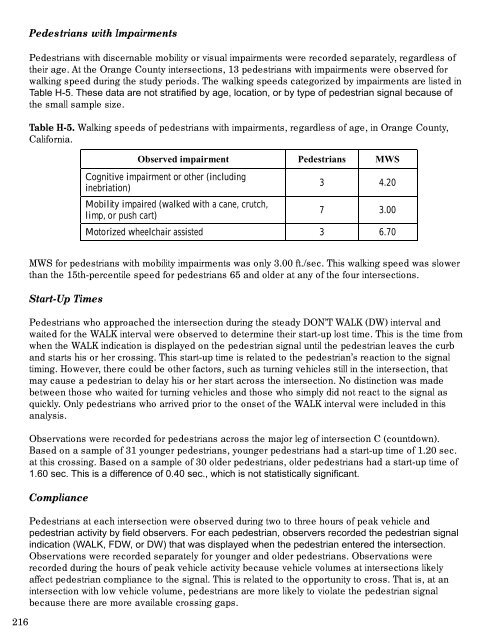Pedestrian Signal Safety - AAA Foundation for Traffic Safety
Pedestrian Signal Safety - AAA Foundation for Traffic Safety
Pedestrian Signal Safety - AAA Foundation for Traffic Safety
You also want an ePaper? Increase the reach of your titles
YUMPU automatically turns print PDFs into web optimized ePapers that Google loves.
216<br />
<strong>Pedestrian</strong>s with Impairments<br />
<strong>Pedestrian</strong>s with discernable mobility or visual impairments were recorded separately, regardless of<br />
their age. At the Orange County intersections, 13 pedestrians with impairments were observed <strong>for</strong><br />
walking speed during the study periods. The walking speeds categorized by impairments are listed in<br />
Table H-5. These data are not stratified by age, location, or by type of pedestrian signal because of<br />
the small sample size.<br />
Table H-5. Walking speeds of pedestrians with impairments, regardless of age, in Orange County,<br />
Cali<strong>for</strong>nia.<br />
Observed impairment <strong>Pedestrian</strong>s MWS<br />
Cognitive impairment or other (including<br />
inebriation)<br />
Mobility impaired (walked with a cane, crutch,<br />
limp, or push cart)<br />
3 4.20<br />
7 3.00<br />
Motorized wheelchair assisted 3 6.70<br />
MWS <strong>for</strong> pedestrians with mobility impairments was only 3.00 ft./sec. This walking speed was slower<br />
than the 15th-percentile speed <strong>for</strong> pedestrians 65 and older at any of the four intersections.<br />
Start-Up Times<br />
<strong>Pedestrian</strong>s who approached the intersection during the steady DON’T WALK (DW) interval and<br />
waited <strong>for</strong> the WALK interval were observed to determine their start-up lost time. This is the time from<br />
when the WALK indication is displayed on the pedestrian signal until the pedestrian leaves the curb<br />
and starts his or her crossing. This start-up time is related to the pedestrian’s reaction to the signal<br />
timing. However, there could be other factors, such as turning vehicles still in the intersection, that<br />
may cause a pedestrian to delay his or her start across the intersection. No distinction was made<br />
between those who waited <strong>for</strong> turning vehicles and those who simply did not react to the signal as<br />
quickly. Only pedestrians who arrived prior to the onset of the WALK interval were included in this<br />
analysis.<br />
Observations were recorded <strong>for</strong> pedestrians across the major leg of intersection C (countdown).<br />
Based on a sample of 31 younger pedestrians, younger pedestrians had a start-up time of 1.20 sec.<br />
at this crossing. Based on a sample of 30 older pedestrians, older pedestrians had a start-up time of<br />
1.60 sec. This is a difference of 0.40 sec., which is not statistically significant.<br />
Compliance<br />
<strong>Pedestrian</strong>s at each intersection were observed during two to three hours of peak vehicle and<br />
pedestrian activity by field observers. For each pedestrian, observers recorded the pedestrian signal<br />
indication (WALK, FDW, or DW) that was displayed when the pedestrian entered the intersection.<br />
Observations were recorded separately <strong>for</strong> younger and older pedestrians. Observations were<br />
recorded during the hours of peak vehicle activity because vehicle volumes at intersections likely<br />
affect pedestrian compliance to the signal. This is related to the opportunity to cross. That is, at an<br />
intersection with low vehicle volume, pedestrians are more likely to violate the pedestrian signal<br />
because there are more available crossing gaps.








